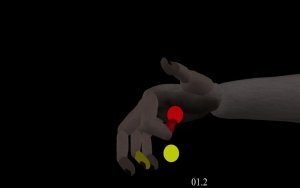Presented By: Michigan Robotics
Understanding Motor Control for Assistive Technologies: From Biomechanics to Brain-Machine Interfaces
Robotics PhD Defense, Luis Cubillos

Co-chairs: Cynthia Chestek and Chandramouli Krishnan
Abstract:
Millions of people in the world suffer from disorders that affect their motor control, including conditions like spinal cord injuries, strokes, and neurodegenerative diseases. These impairments can drastically reduce their mobility and independence, creating a need for advanced assistive technologies. This defense addresses these challenges by exploring how humans move and learn new motor skills, and how these insights may inform better assistive technologies, especially through brain-machine interfaces.
We first focus on the biomechanics of the ankle joint, studying the reliability of its stiffness, viscosity, and inertia while standing and walking. The results show that stiffness and viscosity can be reliably estimated and may be valuable as a clinical metric as well as a goal for biomimetic prosthetic control.
Then, we show the development of a new open-source web application for motor learning experiment design and show its validation for replicating previous studies, as well as for investigating how motor learning is transferred between limbs. Our results show that even short periods of rest can greatly improve motor skill learning as well as the existence of interlimb transfer learning.
Finally, we apply these insights in the context of brain-machine interfaces, assistive devices that have helped restore motor and speech control by decoding signals from the brain. We evaluate the trade-offs of using an interpretable algorithmic approach that combined a principled approach with deep-learning for decoding finger movements from brain data. We found that explainability may not need to be sacrificed for good performance, and that an interpretable algorithm can provide insights into motor control as well as future avenues for model improvement.
Overall, by integrating these distinct but related areas, this defense contributes to a comprehensive understanding of human motor control and how to improve it. Together, these contributions provide a foundation for assistive technologies that can restore mobility, enhance independence, and improve quality of life for individuals living with motor impairments.
FRB 2300 and on Zoom: https://umich.zoom.us/j/96288303600
Abstract:
Millions of people in the world suffer from disorders that affect their motor control, including conditions like spinal cord injuries, strokes, and neurodegenerative diseases. These impairments can drastically reduce their mobility and independence, creating a need for advanced assistive technologies. This defense addresses these challenges by exploring how humans move and learn new motor skills, and how these insights may inform better assistive technologies, especially through brain-machine interfaces.
We first focus on the biomechanics of the ankle joint, studying the reliability of its stiffness, viscosity, and inertia while standing and walking. The results show that stiffness and viscosity can be reliably estimated and may be valuable as a clinical metric as well as a goal for biomimetic prosthetic control.
Then, we show the development of a new open-source web application for motor learning experiment design and show its validation for replicating previous studies, as well as for investigating how motor learning is transferred between limbs. Our results show that even short periods of rest can greatly improve motor skill learning as well as the existence of interlimb transfer learning.
Finally, we apply these insights in the context of brain-machine interfaces, assistive devices that have helped restore motor and speech control by decoding signals from the brain. We evaluate the trade-offs of using an interpretable algorithmic approach that combined a principled approach with deep-learning for decoding finger movements from brain data. We found that explainability may not need to be sacrificed for good performance, and that an interpretable algorithm can provide insights into motor control as well as future avenues for model improvement.
Overall, by integrating these distinct but related areas, this defense contributes to a comprehensive understanding of human motor control and how to improve it. Together, these contributions provide a foundation for assistive technologies that can restore mobility, enhance independence, and improve quality of life for individuals living with motor impairments.
FRB 2300 and on Zoom: https://umich.zoom.us/j/96288303600